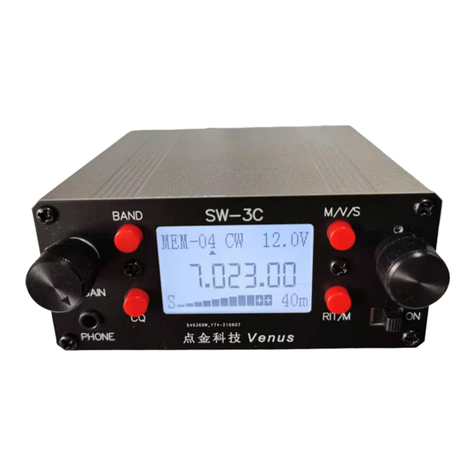
Backlight Mode Selection
Press and hold the M/V/SAV button and the RT/MOD button simultaneously to enter the backlight setting state.
Turn the large knob to change the backlight setting. The backlight of the LCD has three settings: ON is the
backlight always on, OFF is the backlight is always off, AUTO is automatic, if you select the automatic, if the
machine is not operated for 10 seconds, the backlight will automatically turn off, and the backlight will
automatically turn on when the machine is operated. Press and hold the M/V/SAV button and the RT/MOD button
simultaneously to exit the backlight setting state.
Transmitting
Allowed transmission frequencies are: 7.0-7.2 MHz, 10.1-10.15 MHz, and 14.0-14.35 MHz. When the signal is
sent within these frequency ranges, the display will show the word TX, and the red LED on the right side of the
panel will flash with the code. When not transmitting in these frequency ranges, it will be invalid. The ERROR will
be displayed on the display. No signal will be sent from the antenna, but the side tone can still be heard. You can
use this feature as a code trainer.
Electronics keyer
1. Automatic Calling:
Short press the CQ button to release it immediately, that is, automatically call CQ CQ de + call sign twice + K. If you want
to cancel the automatic call during the automatic call, press the CQ button for 1 second and release it. The following 2 and 3
operations must be performed in the automatic key state, and invalid when using the key.
2. Speed adjustment:
Press the CQ button and hold it. After about 2 seconds, you will hear dit dit dit (Moores code letter S). At this
time, release the CQ button, and the auto button will be dialed to “point” speed. Slow down to the "scratch" speed.
At the right speed (you will automatically exit after 8 seconds of input and keep the original speed). Short press
the CQ button to release it immediately, hear dit (Moores code E) exit, or wait for about 8 seconds to exit
automatically.
3. Call sign input:
Press the CQ button and hold it. After about 2 seconds, you will hear dit dit dit (Morse code letter S), continue
to hold down the CQ button, and hear it after about 2 seconds (Morse code) The letter I), at this time release the
CQ button, use the automatic button to dial your call sign as usual (unless input will automatically exit after 8
seconds, and keep the original call sign). After the hair is sent, press the CQ button and release it immediately.
When you hear dit (Moores code E), or wait for about 8 seconds to exit automatically. When the speed
adjustment and call sign input status are entered, the display will show the word TX, which is normal.
























